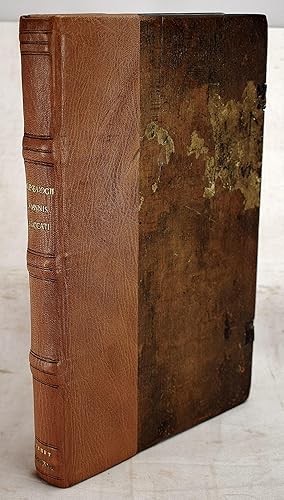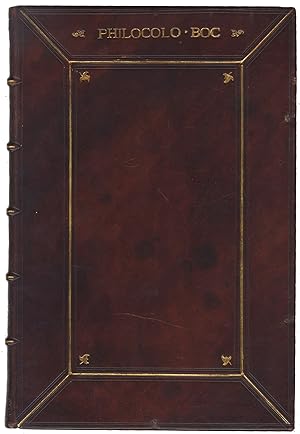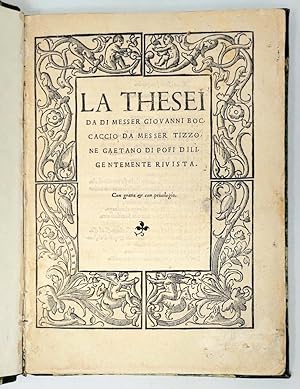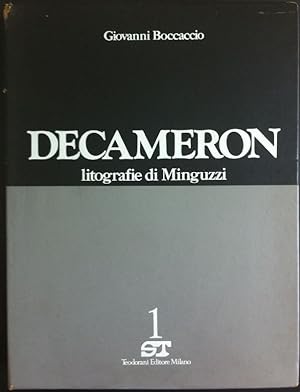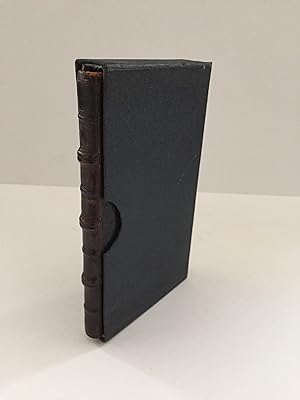boccaccio, Rilegato (Oltre 6.700 risultati)
Tipo di articolo
- Tutti gli articoli
- Libri (6.792)
- Riviste e Giornali
- Fumetti
- Spartiti
- Arte, Stampe e Poster (1)
- Fotografie
- Mappe
-
Manoscritti e
Collezionismo cartaceo
Condizioni
Legatura
Ulteriori caratteristiche
- Prima edizione (416)
- Copia autografata (48)
- Sovraccoperta (749)
- Con foto (3.657)
- No print on demand (5.218)
Spedizione gratuita
Paese del venditore
Valutazione venditore
-
The Decameron.
Editore: Isaac Jaggard, London, 1620
Da: Raptis Rare Books, Palm Beach, FL, U.S.A.
Prima edizione
First edition in English of Boccaccio's masterpiece, published by Jaggard published three years prior to his printing of the Shakespeare First Folio. Boccaccio's masterpiece. Folio, 2 volumes, bound in full morocco by Riviere, gilt titles and tooling to the spine, all edges gilt, errata leaf at end of volume one, B1 is a cancellans, woodcut titles each with 6 vignettes, 98 woodcut vignettes in text chiefly repeating the title vignettes, woodcut initials, head- and tail-pieces. In near fine condition. First editions are rare. The Decameron is a collection of novellas by the 14th-century Italian author Giovanni Boccaccio (1313â "1375). The book is structured as a frame story containing 100 tales told by a group of seven young women and three young men sheltering in a secluded villa just outside Florence to escape the Black Death, which was afflicting the city. Boccaccio probably conceived the Decameron after the epidemic of 1348, and completed it by 1353. The various tales of love in The Decameron range from the erotic to the tragic. Tales of wit, practical jokes, and life lessons contribute to the mosaic. In addition to its literary value and widespread influence (for example on Chaucer's The Canterbury Tales), it provides a document of life at the time. Written in the vernacular of the Florentine language, it is considered a masterpiece of classical early Italian prose.
-
Il Decamerone di m. Giouanni Boccaccio nuouamente corretto et con diligentia stampato.
Editore: Florence, eredi di Filippo Giunta il vecchio, 1527
Da: MEDA RIQUIER RARE BOOKS LTD, London, Regno Unito
Quarto (194 x 131 mm.), [8] leaves, 284 pages with woodcut printer's device on title-page and on verso of last page. Lightly washed, contemporary manuscript annotations on tile-page and inital pages, overall a very good copy bound by Traut-Bauzonnet in red morocco, gilt arabesque on covers, spine in compartments with gilt title and ornaments, gilt edges.The superb Ventisettana ? one of the most famous, handsomely-printed and philologically accurate editions of the Decameron. ?The best edition produced until that moment; it has long been much esteemed among bibliophiles [?]. Although less rare than the 1516 Giunti edition and many others of the time, it is very difficult to find, especially in good condition' (Brunet I, 998-99).One of Florence's literary talents, the poet and humanist Giovanni Boccaccio (1313-75) devised his Decameron probably after the notorious plague of 1348. Completed in 1353, it is a collection of 100 short stories in the vernacular, told in the course of ten days by a group of young women and men who have taken refuge in a villa outside Florence to escape an epidemic. To pass the time in the evenings, they tell tales of love, wit and tragedy, whether adapted from traditional folklore or borrowed from medieval works and even from unusual sources like translations of Persian and Arabic literature.This edition, especially cherished in 16th-century Florence, was printed in the year in which the Medici rule was temporarily overthrown by the republican forces. Several of the scholars involved in the making of the Ventisettana, including Pier Vettori, Bernardo di Lorenzo Segni and Bartolomeo Cavalcanti, were themselves opposers of the Medici, a political circumstance which probably determined the work's subsequent rarity (Gamba, Delle novelle, 16). The scholars revised Delfino's 1516 Venetian edition by collating the text against further authoritative manuscripts, including the 14th-century Mannelli scribal copy, preserved at the Laurenziana. Only in 1761 did another edition, based entirely on the Mannelli manuscript, supersede it.According to Renouard, ?few books have become as esteemed and valuable as this volume [?] considered, as soon as it appeared in print, as the prototype, the obligatory model for all future editions' (?Notices', 93). In 1729, since the edition had become so scarce, the bibliophile and art collector, Consul Joseph Smith, famously commissioned a type facsimile in 300 copies from the Venetian printer Pasinello. It is notoriously of fine quality, so much so that Brunet (I, 999) felt the necessity to list the differences and help his bibliophile-readers to tell them apart. EDIT16 CNCE 6271; Brunet I, 998-99; Gamba, Delle novelle italiane in prosa, 14-17; Renouard, ?Notices sur la famille des Juntes', 93. WorldCat locates 11 copies in the US (Xavier, Huntington, Pierpont Morgan, UCB, Delaware, HRC, UCLA, Claremont, Brown, Williams, UPenn). B. Richardson, ?The Textual History of the Decameron', in Boccaccio : A Critical Guide to the Complete Works, ed. V. Kircham et al. (Chicago, 2013), 41-52. .
-
Boccaccio, Giovanni (1313-1375). Il Decamerone di messer Giouanni Bocchaccio nuouamente stampato con tre nouelle aggiunte. Florence, Filippo Giunta, 29 July 1516.
Editore: Florence, Filippo Giunta, 29 July 1516., 1516
Hardcover. Condizione: Very Good. 4° (190x118 mm). Collation: AA8, a-z8, &8, [cum]8, [rum]8, A-O8, P10. [8], 329, [1] leaves. Italic and roman type. Woodcut printer s device on the verso of fol. P10v. Blank spaces for capitals, with printed guide letters. Large woodcut on fol. a1r, at the beginning of the Proemio (74x93 mm) and subsequently repeated six more times (fols. d5v, y6r, [cum]6r, A7v, F3v, and H7v), representing Boccaccio s brigade of storytellers seven women and three men seated in a garden, with the figures labelled on the block. Ninety- six smaller woodcut vignettes (43x70 mm), including one repeat, with most of these figures labelled on the block. Late eighteenth-century red morocco, covers framed within triple gilt fillet, a small flower at each corner. Smooth spine, divided into compartments by narrow gilt ornamental rolls. Small gilt tool work in the compartments, the title decamerone del boccaccio in gold. Board edges gilt tooled, marbled pastedowns and flyleaves, inside dentelles, pale green silk bookmark. Gilt edges. A few minor scratches to the upper covers. A very fine copy, first and last leaves slightly dusted. Provenance: from the library of the great collector and politician from Naples Luigi Serra, 4th Duke of Cassano (1747-1825; ownership inscription Del Duca di Cassano on the verso of the front marbled flyleaf). The first Giuntine edition of Boccaccio s masterpiece, a finely illustrated edition very rarely found on the auction market. The 1516 Decameron is introduced, on the verso of the title-page, by an address to the reader ( messer giovanni bocchaccio al lectore ), in which the printer Bernardo Giunta, disguised as Boccaccio himself, praises the Giuntine edition over all others and praises Filippo Giunta s initiative of recovering Boccaccio s original text. This is the first textual evidence available in an edition which indicates that Boccaccio was beginning to appeal to scholarly readers (R. Daniels, Boccaccio and the Book, p. 108). The edition occupies an important position in the textual history of the Decameron, for while it is mainly based on the previous Florentine edition, it was corrected using early manuscripts, or as Bernardo Giunta states piu testi dallo originale transcripti (fol. AA1v) possibly including a manuscript transcribed from authorial originals. Further, the Decameron of 1516 offers the first appearance in print of three additional novellas then erroneously attributed to Boccaccio and nuouamente ritrouate (fol. N6r), i.e. recently rediscovered : the anonymous Bonaccorso di Lapo Giovanni, the Bianco Alfani, possibly composed by Piero di Filippo del Nero, and above all the Grasso Legnaiolo, one of the most famous novellas of the Renaissance, now generally attributed to the Florentine Feo Belcari (1410-1484). The inclusion of these works suggests the use of a still unidentified manuscript containing these novellas, whose language and narrative share characteristics with the Decameron. The woodcuts illustrating this Florentine edition are highly praised, and rightly so. They are reverse free copies of the vignettes included in the first illustrated Decameron printed in Italy, which was issued in Venice in 1492 by Giovanni and Gregorio de Gregori. A great success, the Venetian illustrative set was subsequently adopted by other Venetian printers such as Manfredo Bonelli, for the Decameron of 1498, and Bartolomeo Zanni, for his editions of 1504 and 1510. There are a few points at which the illustration varies from that in the 1504 edition [printed in Venice by Bartolomeo Zanni], and may depend on the fifteenth-century editions. Apparently someone at Giunta s press began to censor the blocks. On leaves e2v and l6v, parts of the blocks have been cut off or masked; similar scenes later in the volume are left intact (Mortimer Italian, p. 95). It is noteworthy that the rival edition issued by the Venetian printer de Gregori, likewise in 1516, is without illustrations, and that.(cont'd).
-
Laberinto d'amore. con una Epistola à Messer Pino de rossi confortatoria del medesimo autore
Editore: Florence, Heirs of Filippo Giunta, 1521, 1521
8° (160x95 mm). Collation: A-I8. 72 leaves. Roman and italic type. Blank spaces for capitals, with printed guide letters. Fine contemporary Venetian red morocco over pasteboards. Covers within blind fillets and a gilt acorn and leaf roll. At the centre of both covers two gilt strapwork-pattern tools, the gilt letters ".F.G.T.' on the upper cover and ". M.A.G.D.' onthe lower one. Two pairs of holes for ties at the fore-edge. Spine with three small raised bands, with title inked in an early hand. Gilt and gauffered edges. Corners lightly rubbed, minor wear to extremities of spine, joints lightly restored. A fine copy, first leaf lightly soiled and spotted, some marginal foxing, a few spots and minor stains. A few maniculae in a contemporary hand. Small nineteenth-century paper label pasted to front pastedown, with shelfmark "N.° 1395A.II.2'. Some pencilled bibliographical notes on pastedowns. Provenance: Francesco Riccardi de Vernaccia (b. 1794; engraved ex libris on the front pastedown); Gustavo Camillo Galletti (1805-1868; small stamp on recto of first leaf); Baron Horace de Landau (1824-1903; ex libris on frontpastedown, with stamped number "47788'). $ 28,000 A finely bound copy of this rare Giuntina edition of one of the most influential works by Boccaccio, one ofthe Three Crowns of Italian literature. The Labirinto d'amore was written in the mid-1350s; it is also known as Corbaccio, an alternative title introduced in the Florentine editio princeps of 1487, although the word "corbaccio' never actually occurs in the work. It certainly derives from the Italian "corvo', i.e., crow, possibly recalling the satire Ibis by Ovid, one of Boccaccio's favourite sources. The text was edited by Bernardo Giunta, who addressed his publishing initiative to "gli Amatori della Lingua Toscana' – admirers of Tuscan language – emphasizing Boccaccio's critical early role in the tradition of Italian vernacular prose.This copy is housed in a fine contemporary binding in red morocco of the highest quality, suggesting that it was executed for a wealthy patron, the identity of whom remains hidden despite the gilt lettering on itscovers, ".F.G.T.', and ".M.A.G.D.'. The binding was in all likelihood produced in a Venetian workshop, owing to the lettering employed in these inscriptions as well as the use of the knot-tool, a fairly common tool design used by various Venetian binders; this tool even came to act as a sort of signature of the most inventive and talented craftsman, the Mendoza Binder, so-named because of his main client, the Spanish ambassador Diego Hurtado de Mendoza, who was active there between ca. 1520 and 1555 (see, for example, The Henry Davis Gift, no. 262, for a binding by the Mendoza Binder dated to ca. 1523, bearing the sameknot-tool and an inscription in a similar pattern). The fine border framing the covers is formed with small mirror leaves and acorn tools, decorative motifs likewise used in various Venetian binder's workshops in the first decades of the Cinquecento. Adams B-2182; M. A. Foot, The Henry Davis Gift: A Collection of Book Bindings III, London 1978; L. Nuvoloni, "Commissioni dogali. Venetian Bookbindings in the British Library", D. Pearson (ed.), "For the Love of Binding', Studies in Bookbinding History Presented to Mirjam Foot, London-Newcastle, DE 2000, pp. 81-109.
-
Modell of Wit, Mirth, Eloquence, and Conversation Framed in Ten Dayes, of an hundred curious Pieces, by Seven Honourable Ladies, and three Noble Gentlemen. Preserved for Posterity by the Renowned John Boccacio, the first Refiner of Italian Prose: And now translated into English.
Editore: Isaac Jaggard, London, 1625
Da: Heritage Book Shop, ABAA, Beverly Hills, CA, U.S.A.
The Modell of Wit, Mirth, Eloquence, and Conversation. Framed in Ten Dayes, of an hundred curious Pieces, by Seven Honourable Ladies, and three Noble Gentlemen. Preserved for Posterity by the Renowned John Boccacio, the first Refiner of Italian Prose: And now translated into English. London: Isaac Jaggard, 1625. Full Description: BOCCACCIO, Giovanni. The Modell of Wit, Mirth, Eloquence, and Conversation. Framed in Ten Dayes, of an hundred curious Pieces, by Seven Honourable Ladies, and three Noble Gentlemen. Preserved for Posterity by the Renowned John Boccacio, the first Refiner of Italian Prose: And now translated into English. London: Isaac Jaggard, 1625. [Bound with]: The Decameron, containing an hundred pleasant novels. Wittily discoursed betweene seven Honourable Ladies and three Noble Gentlemen. The last Five Dayes. London: Isaac Jaggard, 1620. Second edition in English of Volume I, first edition of Volume II. The 1620 printing of the first volume is comparatively rare. Together two quarto volumes bound in one. (10 7/8 x 6 7/8 inches; 276 x 174 mm). [5], 193; [13], 134, 137-187 [ie 188] leaves. Bound without first and final blank in both volume. Numerous mispaginations, but textually complete. Engraved title pages, each title-page within an elaborate woodcut border. With ninety-eight woodcut illustrations (including repeats of portions of borders). Numerous woodcut initials, head- and tail-pieces throughout the text. Late eighteenth-century calf, neatly rebacked, with original spine laid down. Spine richly tooled in gilt, with a red morocco lettering label. Marbled endpapers. Edges dyed red. A bit of light marginal dampstaining. Leaf Ee3 with some tears to the blank fore-edge margin. Previous owner's bookplate on front pastedown. Overall, a very good copy, attractively bound. The first English translation of Boccaccio's Decameron was possibly translated by John Florio, the Italian Lexicographer who is best known for his English version of Montaigne. The printer Jaggard must have still had sheets of Volume II available when a new edition of his Decameron was called for as it was never necessary to reprint the second half of the text. The first issue of this volume was published three years before the first folio of Shakespeare (1623), and produced by the same printer, Isaac Jaggard. Boccaccio, "the father of Italian prose," strongly influenced both Shakespeare (most evident in "Troilus and Cressida") and Chaucer. Although now regarded as one of the greatest of literary classics, his Decameron has had an extraordinary controversial history. In 1497, manuscripts and printed parts were thrown into Savaronola's Bonfire of the Vanities, while in 1559, at the direction of Pope Paul IV, the book was prohibited in all but a grossly expurgated form. A most important edition of this superb, beautifully illustrated literary landmark. Grolier, Wither to Prior, 250. Pforzheimer 71 and 72. STC 3172 and 3173. See Haight, Banned Books, 7-8, and Printing and The Mind of Man, 115. HBS 68865. $25,000.
-
[The Decameron.] The Modell of Wit, Mirth, Eloquence, and Conversation
Editore: Printed by Isaac Jaggard, for Mathew Lownes, 1625 and, London, 1620
Da: Liber Antiquus Early Books & Manuscripts, Chevy Chase, MD, U.S.A.
Prima edizione
Hardcover. Condizione: Fine. Bound in contemporary English calf ruled in blind, neatly rebacked retaining the original spine, corners mended, later end-leaves. A crisp copy with minor scattered stains and clean tears (no loss). Light ink stain to first title, light dampstain to lower blank margin of first two gatherings, slight chipping to lower corner of first two lvs. Small rust holes in lvs. E3-4, M3-4, and Dd1-2; small marginal paper flaw to lvs. M1 and 2nd Dd3, lvs. O6 and Ss3 (Pt. 2) with tears in text (no loss), 2nd Oo2 with sm. repaired hole. With the bookplates of Shuttleworth Forcett; Kap Shuttleworth, Cawthorpe Hall; and Stuart W. Jackson; housed in chemise and half-morocco slipcase. Title page of the first volume printed with a woodcut border (McKerrow & Ferguson 212); The second volume with an illustrated woodcut title-page with six illustrations within oval frames. Illustrated throughout with small woodcut scenes. "The woodcuts are of French origin, based on those used in a 1558 French translation printed at Lyons by Guillaume Rouillé." The printer John Wolfe may have attempted to publish either an Italian version or English translation of the "Decameron" in 1587, when it was entered on the Stationers' Register in his name, but no trace of this work survives, so we may presume it was never published. "The "Decameron", collection of tales byGiovanni Boccaccio, probably composed between 1349 and 1353. The work is regarded as a masterpiece of classical Italian prose. Whileromanticin tone and form, it breaks frommedievalsensibility in its insistence on the human ability to overcome, even exploit, fortune. "The"Decameron" comprisesa group of stories united by aframe story. As the frame narrative opens, 10 young people (seven women and three men) flee plague-stricken Florence in 1348 to a delightful villa in nearby Fiesole. Each person rules for a day and sets stipulations for the daily tales to be told by all participants, resulting in a collection of 100 pieces. Each day ends with a canzone (song), and some of these represent Boccaccio's finest poetry. "Each daily collection of stories takes a different tone or theme. Day 1 consists of a witty discussion of human vices. On Day 2, fortune triumphs over its human playthings, but it is trounced by human will on Day 3. Day 4 is marked by tragic love stories. Day 5 brings happy endings to love that does not at first run smoothly. Wit and gaiety again reign on Day 6. Trickery, deceit, and often bawdy license run free on Days 7, 8, and 9. By Day 10, earlier themes are brought to a high pitch; the widely borrowed story "ThePatient Griselda" closes the cycle of tales. "It was probably in the years 1348-53 that Boccaccio composed the"Decameron"in the form in which it is read today. In the broad sweep of its range and its alternately tragic and comic views of life, it is rightly regarded as his masterpiece; its influence on Renaissanceliteraturethroughout Europe was enormous. "The"Decameron"begins with the flight of 10 young people (7 women and 3 men) from plague-strickenFlorencein 1348. They retire to a rich, well-watered countryside, where, in the course of a fortnight, each member of the party has a turn as king or queen over the others, deciding in detail how their day shall be spent and directing their leisurely walks, their outdoor conversations, their dances and songs, and, above all, their alternate storytelling. This storytelling occupies 10 days of the fortnight (the rest being set aside for personal adornment or for religious devotions); hence the title of the book itself,"Decameron", or "Ten Days' Work." The stories thus amount to 100 in all. Each of the days, moreover, ends with a canzone (song) for dancing sung by one of the storytellers, and these canzoni include some of Boccaccio's finestlyric poetry. In addition to the 100 stories, Boccaccio has a master theme, namely, the way of life of the refinedbourgeoisie, who combined respect for conventions with an open-minded attitude to personal behaviour. "The sombre tones of the opening passages of the book, in which the plague and themoraland socialchaosthat accompanies it are described in the grand manner, are in sharp contrast to the scintillating liveliness of Day I, which is spent almost entirely in witty disputation, and to the playful atmosphere of intrigue that characterizes the tales of adventure or deception related on Days II and III. With Day IV and its stories of unhappy love, the gloomy note returns; but Day V brings some relief, though it does not entirely dissipate the echo of solemnity, by giving happy endings to stories of love that does not at first run smoothly. Day VI reintroduces the gaiety of Day I andconstitutesthe overture to the great comic score, Days VII, VIII, and IX, which are given over to laughter, trickery, and license. Finally, in Day X, all the themes of the preceding days are brought to a high pitch, the impure made pure and the common made heroic. "The prefaces to the days and to the individual stories and certain passages of especial magnificence based on classical models, with their select vocabulary and elaborate periods, have long held the attention of critics. But there is also another Boccaccio: the master of the spoken word and of theswift, vivid, tense narrative free from the proliferation of ornament. These two aspects of the"Decameron"made it the fountainhead of Italian literary prose for the following centuries. "It is the spirit in which Boccaccio treats his subjects and his forms that is new. For the first time in the Middle Ages, Boccaccio in the"Decameron"deliberately shows people striving with fortune and learning to overcome it. To be truly noble, according to the"Decameron", people must accept life as it is, without bitterness, must accept, above all, the consequences of their own action, however contrary to their expectation or even tragic they may be. To realize our own earthly happiness, we must confine our desire to what is humanly possible and ren.
-
The modell of VVit, Mirth, Eloquence, and Consueration. Framed in Ten Dayes, of an hundred curious Pieces, by seven Honorable Ladies, and three Noble Gentlemen. [with] The Decameron, containing An hundred pleasant Novels.
Editore: Isaac Jaggard for Matthew Lownes, 1625
Da: Sokol Books Ltd. ABA ILAB, London, Regno Unito
Libro
Hardcover. Condizione: Good. Two works in one. FIRST ENGLISH EDITION of the second, second English edition of the first. Folio. Ff. (v) 193; (xv) 187. Roman letter, some Italic. 1: Woodcut tp with frontispiece reused from 1593 edition of Sidney s Arcadia (McKerrow & Ferguson 212). 2: Woodcut tp with six woodcuts (the same as those printed within the texts of both works) within ornamental border. Floriated woodcut headpieces and initials and ornamental tail pieces, half page woodcuts interspersed with scenes of civilian life including dining, bathing and dancing, throughout both works. Engraved armorial bookplate of Thomas Hamilton, 7th Earl of Haddington (1721-1794) to verso of first tp, ms to tp and fly E 3 = 2 , autograph to tp J Badminton (John Badminton (1777-?)). Ms to page edges Boccacc between star and heart. Slight browning to first tp, light age yellowing. Occasional light oil and ink spots, mainly marginal, light foxing or browning to last couple of leaves. A clean and handsome copy with very generous margins in contemporary speckled calf with triple blind ruled border, spine rebacked C19, aer. Two of the first editions of Giovanni Boccaccio s (1313-1375) Decameron, translated into English and printed by Isaac Jagaard (? 1627), printer of Shakespeare s First Folio. The Decameron was translated into English remarkably late, having previously been read by English readers in the original Italian or via the French translation. The anonymous translator states that the patronage of Sir Philip Herbert, Earl of Montgomery (1584-1650) supported the publication of the pioneering first English edition as well as the second edition of Volume 1. Herbert was a prominent courtier and nobleman, and formed one half of the incomparable pair of brethren to whom Shakespeare s First Folio was dedicated in 1623. The first edition and Vol 1 of the second edition of The modell of VVit, Mirth, Eloquence, and Consueration are present in this copy; a second edition of Vol 2 was not published. The 1620 edition follows the Italian source text in its composition (Armstrong, Guyda. Paratexts and Their Functions in Seventeenth-Century English Decamerons , 2007), but some elements are omitted: two tales are replaced for being unsavoury to contemporary English tastes, for example the last tale of the Third day is substituted for the story of the prudent princess Serictha. Both editions are deluxe products in folio format, generously illustrated with decorative title-pages, woodcuts, ornaments, and illuminated capital letters. (Guyda, 2007). The books were marketed as forms of entertainment, with the change to a more informative title in the second edition arising from a desire to present the work as an important source of knowledge and indispensable work of Italian early modern literature. Interestingly, in the first edition Boccacio s name is absent. The presence of the Renowned Boccacio on the second edition demonstrates the success of the first edition, and consequential increased fame of the original author. Pforzheimer 71 states that Shakespeare used Boccaccio s tales in several of his plays. The woodcut on the tp of the second edition is reused from the 1593 edition of Sidney s Arcadia. The same design was also used in a 1595 translation of Machiavelli s Florentine History, a 1633 edition of Sidney s collected works as well as a 1617 edition of Spenser s collection works. Because of this, the ornamental border contains a number of specific allusions to Sidney s Arcadia: the central characters of Musidorus, Pyrocles, Dorus, and Cleophila feature, as well as the author s family crest. The lower emblem depicts a boar retreating from a marjoram bush with the motto Spiro Non Tibi . The animal recoils from the nutritious and beneficial source of food, demonstrating his own poor judgement, and thus giving a lesson on the condemnation of ignorance.
-
Peri genealogias deorum, libri quindecim.
Editore: Basel, Johann Herwagen, 1532., 1532
Da: Antiquariat INLIBRIS Gilhofer Nfg. GmbH, Vienna, A, Austria
Prima edizione
Folio (220 x 310 mm). (68), 504, (4) pp., including errata leaf. With numerous woodcut initials and 13 woodcut family trees, woodcut devices on title page and final leaf. Contemporary full calf elaborately tooled in gilt with gilt armorial device. First printing of Jakob Moltzer's humanist edition of the "Genealogia deorum gentilium", Boccaccio's monumental encyclopedia of over seven hundred pagan gods whose tangled ancestries are carefully traced in woodcut family tree diagrams accompanying the text. These diagrams can be traced back to the earliest manuscript tradition of the Genealogia, and are famously one of the earliest usages of this style of family tree for a secular purpose. Based on the Paris edition of 1511, the Basel edition features new editorial material and indices, but eight of the thirteen woodcut genealogical trees are printed from the actual blocks used in Paris (III, IV, VI, and IX-XIII); the remaining five being slightly simplified copies. - Remarkably, this copy's binding displays the arms of a largely unidentified owner, known only to have the name P. de Beaulieu and to have had a similar binding commissioned in Paris. The armorial shield, enclosed within a circular wreath, is situated in the centre of the elaborately tooled front and rear covers, and is one of the earliest armorial stamps of the modern type. The first collector to order a series of such armorial bindings was Benoît Le Court of Lyon, who adopted the custom about 1540. The fashion carried to Paris, where it was taken up by Jean Brinon, Cardinal Charles de Lorraine, and several unidentified collectors. Anthony Hobson surveyed the introduction of the style, identifying 13 stamps in use by 1550, and recording their usage. One example of the present stamp was known to Hobson from the J. R. Abbey library, which led to the discovery of the name P. de Beaulieu - but which Beaulieu remains uncertain, and the owner ultimately remains unidentified. What is more certain is that the book made its way to Claude Pellot (1619-83), whose ownership inscription is on the title-page, and first president of the parliament of Normandy. - Some exterior wear and chipping, a few leaves affected by a light dampstain or minor smudging. In very good condition. - 1) P. de Beaulieu (his armorial shield to both covers). - 2) Claude Pellot (1619-83), French lawyer, first president of the Parliament of Normandy, conseiller et maître des requêtes and cousin of the statesman Jean-Baptiste Colbert (ownership inscribed to title-page). - 3) Sydney Richardson Christie-Miller (1874-1931), English collector. - 4) Sold at Sotheby s, London, 31 July-3 Aug. 1917, lot 218, to J. & J. Leighton, London (£6 10s). - 5) Sold at Sotheby s, London, 14-19 Nov. 1918, lot 134, to Davis & Orioli, London (£2 2s). - 6) Sold at Christie s, London, 25 Nov. 1992, lot 130, to Maggs Bros., London (£1,000). Offered in their Catalogue 1157 [1993], item 10). - 7) Thomas Kimball Brooker, oil industry executive (b. 1939). - VD 16, B 5846. BM-STC German 129. Adams B 2173. USTC 667713. OCLC 29085981.
-
La Theseide. Innamoramento piaceuole, and honesto di due Giouani Thebani Arcita and Palemone; D'ottaua Rima nuouamente ridotta In Prosa per Nicolao Granucci di Lucca. Aggiuntoui un breve Dialogo nel principio e fine dell'Opera diliteuole, and vario
Editore: Lucca Vincenzo Busdraghi for Giulio Guidoboni 1579, 1579
8o (154x100 mm). Printed on blue paper. Collation: a8, A-S8 (fol. F4 signed G4). 8, 144 leaves. Roman and italic type. Woodcut printer's device on the title-page. Woodcut decorated seven-line initials and headpieces. Fine Parisian red morocco over pasteboards, signed by Hippolyte Duru, and executed in 1847. Covers within double blind fillet. Spine with five small raised-bands, emphasized by blind fillets; title lettered in gold. Marbled pastedowns and flyleaves; edges-boards decorated with gilt fillet, inside dentelles. Gilt edges. A good copy; restored upper margin of leaves, some letters of the running titles reconstructed at the time of the binding.Provenance: Guglielmo Libri (1803-1869; Catalogue de la Bibliothèque de M L****, Paris 1847, lot 2299, "La Theseide, di Gio Boccaccio. Lucca, Vinc. Busdraghi, 1579, in 8. Mar. r. d. Duru. Exemplaire en papier bleu de cette ouvrage curieux". Sold for 40 francs). Very rare edition of Boccaccio's Teseida, presented here in a copy exceptionally printed on blue paper, and in a fine binding executed for Guglielmo Libri by the renowned Parisian binder Hippolyte Duru. Boccaccio composed the Teseida in order to demonstrate that a classical epic could be written in a vernacular language. The text was produced in three redactions, the first beginning in the early 1340s, and the second and third in the late 1340 and early 1350s. On the model of Vergilius' Aeneis, the poem is divided into twelve books, and consists of 1,238 octaves. The Teseida combines elements from the classical epics and the contemporary tradition of love literature, and was first printed in Ferrara in 1475, edited on the basis of a contaminated text assembled by the Ferrarese Pietro Andrea de' Bassi. After the Venetian edition of 1529, the Teseida appeared again in Italy only fifty years later, thanks to Nicolò Granucci, who rewrote the text in prose. Boccaccio's work had notable popularity in the English literature of the Middle Ages, and served as the primary sources for Geoffrey Chaucer's Knight's Tale, included in his Canterbury Tales. "Several books occupied Chaucer's desk while he was composing The Knight's Tale [.] The most important book on that very crowded desk was the Teseida" (Coleman, The Knight's Tale, p. 87).STC Italian 112; D. Anderson, Before the Knight's Tale. Imitation of Classical Epic in Boccaccio's "Teseida", Philadelphia 1988; W. E. Coleman, "The Knight's Tale", R. M. Correale, M. Hamel. Sources and Analogues of the Canterbury Tales, Cambridge 2005, 2, pp. 87-124; R. Daniels, Boccaccio and the Book, London 2009, p. 57; W. E. Coleman, "Teseida delle nozze d'Emilia", T. De Robertis, C. M. Monti et al. (eds.), Boccaccio autore e copista, Firenze 2013, pp. 89-99; Philobiblon, One Thousand Years of Bibliophily, no. 155. Book.
-
Il Decamerone.
Editore: (Al verso del f. CCCLII:) Impresso in Vinegia per Gregorio de Gregori il mese di Maggio dell'anno MDXVI,, Venezia, 1516
Da: Libreria Antiquaria Pregliasco, Torino, Italia
Condizione: molto buono. in-4 (mm 206x135), ff. (2), CCCLII, (10, ultimo bianco), raffinata e perfetta legatura d'amatore in marocchino nocciola, dorso a 5 nervi con filetti a secco e ricchi fregi in oro, titolo e note su due scomparti; i piatti con elaborata bordura in oro e a secco con volute e terminazioni angolari a racemi (firmata al contropiatto Riviere & Co.). Precede il testo l'inusuale dedica del Delfino "Alle gentil et valorose donne"; in fine Errata e Tavola dell'opera. Prima edizione in formato in-4 e prima a cura del Delfino, che ebbe il merito di riordinare e presentare l'opera boccaccesca nella sua integrità: "ebbe veramente il merito di fare i primi passi per ridonare al Decamerone la sua integrità; per lo che questa edizion salì in molta fama" (Gamba 169). Edizione assai stimata dal punto di vista filologico, è ricercata anche per la sua rarità (censita in sole 10 Biblioteche pubbliche italiane); ".oggi di una sicura rarità. E' la prima edizione che uscisse nel formato di quarto, e la prima in cui si cercasse di ridurre il Decameron alla sua integrità" (cfr. Bacchi della Lega, 34). Edizione preziosissima dal punto di vista filologico, oltre che tipografico. Costituì un notevole balzo in avanti nella qualità testuale, fu curata nel 1516 da Niccolò Delfino , che collazionò il testo dell'edizione mantovana del 1472, che a sua volta si rifaceva sostanzialmente alla princeps, con alcuni manoscritti quattrocenteschi; l'editore infatti "sosteneva di aver restaurato l'opera 'alla sua intera et chiara lettione', selezionando da 'molti antichissimi testi' le parti che sembravano corrispondere maggiormente all'intenzione dell'autore" (Richardson). Ne risultò un testo linguisticamente ineccepibile nella sua coloritura fiorentina trecentesca. E' provato che il Bembo consultò largamente quest'edizione in vista delle Prose della Volgar lingua, stimandola la migliore: "El Boccaccio stampato in Fiorenza del MDXXVII io non ho, che ne corressi uno di questi stampati in Venezia assai prima con un testo antichissimo e perfetto. Ne poi mi ho curato de altro. Ho ben inteso che l'è corretto assai" scrive nella famosa lettera dell'8 marzo 1533 al Ramusio. "Grazie al ritrovamento nel Vat. Chigiano L.VIII.304, f. 239rv di una lista, autografa di Bembo, di voci desunte dal Decameron, Vecce ha riscontrato che i rinvii numerici posti accanto ai passi boccacciani corrispondono alle carte di questa stampa" (cfr. Pulsoni). Sull'edizione Delfino furono esemplate tutte le successive, a partire da quella data dagli eredi di Aldo (Venezia, 1522), che comprende anche le tre novelle pseudo boccaccesche, aggiunte all'opera per la prima volta dai Giunta nel 1516. Ottimo esemplare, fresco e grandi margini (tracce di polvere al titolo e al verso dell'ultimo f. bianco). Ex Libris Roberti Pye de Clifton Campville in Comm. Stafford Baronetti e antiche note possesso: al titolo fregio calligrafico e nota manoscritta: "1640 li 2:7bre Jo Giorgio Barichia Romano comprai questo libro"; all'angolo superiore della dedicatoria: "Nat. Wright 1740". Borromeo p. 7 e V: ''.primo comparve alla luce il più corretto degli altri'' Zambrini 37. Mostre Certaldo n. 48. Olschki n. 3. Pulsoni, ?Postillati Cinquecenteschi del Decameron", Aevum, vol. 83, no. 3, 2009. B. Richardson, Italian Studies Library Group Bulletin, 2010. Book.
-
DECAMERON
Editore: (Pamela Verlag) and (Transworld Art) (1972), (New York and Fribourg), 1972
Da: Charles Agvent, est. 1987, ABAA, ILAB, Fleetwood, PA, U.S.A.
Prima edizione Copia autografata
Hardcover. Condizione: Fine in a Near Fine case. Salvador Dali (illustratore). First Edition. Portfolio with loose sheets (12-1/4" x 17-1/2") laid in a paper cover and cloth portfolio lettered in silver on the backstrip, as issued. Copy #26 of 150 with English text and 10 ORIGINAL DRYPOINT ENGRAVINGS in color (image size 5" x 7-1/4" on 12-1/4" x 17-1/2" sheets), each SIGNED by the illustrator.
-
Genealogiae. Cum demonstrationibus in formis arborum designatis. Eiusdem de montibus & sylvis de fontibus: lacubus: & fluminibus. Ac etiam de stagnis & paludibus: necnon & de maribus: seu diversis maris nominibus.
Editore: Published by Colophon: Bonetus Locatellus for Octavius Scotus, 1494
Da: Stephen Butler Rare Books & Manuscripts, Castlethorpe, PROVI, Regno Unito
Libro Prima edizione
Hardcover. Condizione: Fine. 1st Edition. 13 full-page woodcut genealogies, numerous woodcut initials, 62/3 lines per page, final leaf with printer's device, lower margin of leaf 6 neatly excised not touching text, small worm trail at gutter margin through initial 10 leaves, title with inscription and obliterated inscription which has marked the leaf verso, two leaves faintly spotted, occasional early marginalia, leaves [1], 2-162, folio eighteenth-century vellum, boards with blind-ruled panels and blind-stamped central vignettes, spine with raised bands and morocco labels lettered in gilt, yapp edges, leaves blue-edged, faintly toned, edges rubbed, rear pastedown with armorial bookplates of John Hadden Hindley and James Wyllie Guild (notable Scottish public accountant and antiquarian, whose comprehensive library was sold at Chapman's auction in 1888). Housed in custom drop-down box, A beautiful copy of the fourth edition of the complete text, and the first to include the full-page woodcut genealogies, of Boccaccio's remarkable and highly influential mythography. Boccaccio's friendship with and admiration of Petrarch were instrumental in the writing of the work, completed in 1360 and continually revised until his death in 1374, which drew on many sources, notably the twelfth-century Liber imaginum deorum and the earlier Vatican Mythographies, The influence of this work on the foundation of the Renaissance cannot be overstated, since it was Boccaccio's profound belief, in opposition to contemporary clerical intellectuals, that much could be learned from classical sources without the risk of moral harm to a Christian readership. Genealogiae was Boccaccio's best-known work in his lifetime and remained a key reference work on classical mythology for over 300 years. (King, The Renaissance in Europe, 2003; Hill, Wordsworth, Boccaccio, and the pagan gods of Antiquity, Review of English Studies.1994) (2 parts in 1 vol., the second part on classical geography (from leaf 132v onwards) titled: 'De Montibus: Silvis: Fontibus: Lacubus: Fluminibus: Stagnis: seu Paludibus: de nominibus Maris'.) [With a letter from Ralph Carlson of Garland Publishing suggesting that this copy may have been used as the source for the Genealogiae facsimile issued by the publishing house in 1976] (ISTC: ib00753000; Goff B753; Klebs 190.3; Essling 799).
-
Libro delle donne illustri.
Editore: Venezia, per Comin da Trino a instanza di Andrea Arrivabene, 1545
Da: Sokol Books Ltd. ABA ILAB, London, Regno Unito
Libro Prima edizione
Hardcover. Condizione: Very Good. 1st Edition. [EXQUISITE FUGGER BINDER BINDING] FIRST EDITION thus. 8vo. ff. (xxiv) 139 (i). Italic letter, little Roman. Woodcut vignette to t-p, decorated initials. Marginal worm trails to first and last few ll., some thumbing, mainly marginal spotting in places, intermittent faint oil stain to upper margin, small tear to lower margin of fol. 192. A very good copy in contemporary Venetian olive goatskin, traces of ties, triple blind ruled to a panel design, outer border single gilt ruled with gilt lotus tools and gilt apple tools to corners, centre panel double gilt ruled, gilt cornerpieces with leafy tendrils, large gilt lozenge with gouges, lotus tools and fleurons, spine in four compartments with single gilt ruled raised bands and rolls of leafy tendrils in blind, additional false bands, very minor expert repair to joints and extremities, upper joint slightly cracked, edges gilt and gauffered. C19 bibliographical note to fep, Italian motto (faded) and early ex-libris Di Gioanbattista Giaccarelli and Alex. (?) (faded) at foot of t-p, title inked to lower edge. The exquisite gilt binding can be attributed to the Fugger binder (also Venetian Apple binder ). The tooling reprises very closely the fleurons, lotus and apple tools in de Marinis II, 1707 ter. and 2165, and, especially, the cornerpieces on the centre panel and the blind tooling on the spine in Davis III, 296. Handsomely bound copy of the first edition in Italian of this important work by Boccaccio. One of the Three Crowns of Italian literature, Giovanni Boccaccio (1313-75) was the son of a Florentine merchant who found his poetic vocation during his stay as a canon law student in Naples. His Il Filostrato , Teseida and Decameron had a fundamental influence on European authors, including Chaucer. After becoming acquainted with Petrarch and other humanists in the 1350s, he mostly wrote in Latin. De mulieribus claris , which took 15 years to complete from 1361 to 1375, was not translated into Italian until 1545. The Libro is a gallery of the biographies of 106 women mythological, historical and contemporary presented as exempla of virtuous or wicked behaviour, following the genre of de viris illustribus . The translator, Giuseppe Betussi, a renowned C16 writer and supporter of Italian as a literary language, included in the edition a biography of Boccaccio and additional lives of his own composition. Among Boccaccio s mythological women were the berated Helen, wife of King Menelaus, whose kidnapping by Paris started the Trojan war, and Medusa Gorgone, wearing hair in the form of snakes a feature which Boccaccio dismissed as myth in favour of an historical version in which she was presented as a powerful queen deprived of her wealth by Perseus. The most remarkable of the historical women, Pope Joan of England, was a great scholarly wit who, after passing herself off as a man for years, was appointed pope; she was unmasked whilst giving birth to a secret child during a procession, a fact which, Boccaccio writes, happened because of God s compassion towards his flock, guided in that fashion by a woman . To those of Boccaccio, Betussi added biographies focusing on women who lived between Boccaccio s times and his own, like Isabella, Queen of Spain, celebrated for her support of the crusades in the East, and Vittoria Colonna, a nobildonna , literary wit and devout widow . A beautifully bound milestone of European literature. USTC 814823; Brunet I, 991. Not in BM STC It., Gamba, Gay, Fontanini or Cicognara.
-
Il Decamerone. alla sua intera perfettione ridotto, et con dichiarationi et auuertimenti illustrato, per Girolamo Ruscelli.
Editore: Venice Vincenzo Valgrisi and Baldassare Costantini 1557, Venice, 1557
Condizione: Buono (Good). Two parts in one volume, 4° (219x167 mm). Collation: *4, A-Z8, AA-II8; a-g4 (fol. HH2 signed H2). [8], 496, [16]; [56] pages. Roman and italic type. Valgrisi's serpent device on both title-pages, and at the end. Each giornata introduced by a large woodcut (fols. A5v, D2v, H5v, L8v, O8v, R8v, T5v, Y2r, BB7r, DD6v). Numerous woodcut animated initials. Contemporary French calf, over pasteboards. Covers within double frame of multiple blind fillets, the inner frame with gilt fleurons at outer corners. Device of three interlaced crescents tooled in gilt at centre. Traces of ties. Spine with five raised bands, compartments tooled with a single floral tool, title and the number 'XIII' lettered in gilt. Edges gilt. Minor wear at the head of the spine. A very fine copy, slightly browned on the first leaves, a few paper flaws, minor foxing, some fingermarks.The third and revised Valgrisi edition of Boccaccio's masterpiece, lavishly illustrated, and edited for the Venetian printing house by Girolamo Ruscelli (ca. 1518-1566). The first Decameron from the press of Valgrisi ? the famous printer of French origin, active in Venice from 1540 'all'insegna d'Erasmo' ? had appeared in 1552, and was intended to rival the successful Giolito editions. The work is supplemented by Ruscelli's Vocabolario generale di tutte le voci usate dal Boccaccio, while the preliminary leaves contain, as an introduction, La vita di messer Giouan Boccaccio, written by Francesco Sansovino (1521-1586). The Valgrisi Decameron is one the finest editions of Boccaccio's work produced in the sixteenth century and is rightly famous for its handsome full-page illustrations introducing each giornata, all newly designed and mentioned ? as ?figure nuoue & bellissime? ? on the title-page. Each woodcut is framed within an architectural border including putti, grotesque figures, antique vases, and floral motifs, and depict scenes from the life at the villa of the brigata of young men and women who had fled from Florence during the plague. The success of the publication was immediate, and Valgrisi re-issued Boccaccio's work in 1554, 1555, and 1557, thereby establishing a new iconography of the Decameron in print. The blocks and borders were later re-used by other Venetian printers, including Agostino Zoppino, Onofrio Farri, and Alessandro Vecchi. The Valgrisi Decameron presented here is in a fine contemporary French binding. The covers bear at the centre the device of three interlaced crescents, a feature which might suggest the binding was executed for Diane de Poitiers (1499-1566), mistress of King Henry II of France and from 1548 duchess of Valentinois, who used the triple-crescent device. The exquisite library assembled by this femme bibliophile remained in her Château d'Anet until its sale in 1724. For a similar binding on a copy of Cardanus's De subtilitate (1561) see The Michel Wittock Collection. Part I: Important Renaissance Bookbindings, lot 30. It is noticeable that the crescents also appear on bindings from the King's own library.G. H. Bushnell, 'Diane de Poitiers and Her Books', The Library, 4 (1926-1927), pp. 283-302; J. Porcher, 'Les livres de Diane de Poitiers', Les Trésors des Bibliothèque de France, 26 (1942), pp. 78-89; The Michel Wittock Collection. Part I: Important Renaissance Bookbindings London 2004, lot 30; Philobiblon, One Thousand Years of Bibliophily, no. 121. Book.
-
Decameron - Illustrated with 10 HANDSIGNED ETCHINGS by DALI
Editore: Pamela Verlag, Geneva, 1972
Da: Artfever, Paris, Francia
Libro Prima edizione Copia autografata
Couverture rigide. Condizione: Comme neuf. Condizione sovraccoperta: Très bon. Salvador DALI (illustratore). Ed. numérotée. - PRESENTATION : In-folio in leaves in a yellow case. - ILLUSTRATED : With 10 original color etchings on Arches vellum by DALI. - SIGNATURE : Each eatching is handsigned in pencil by Dali. - LIMITED : 125 copies, here n° 18 / 125. - PRINTER : Atelier Rigal. - PAPER : Arches Vellum. - SIZE : 18 x 13" (45 x 32cm). - DESCRIPTION : Text in French : one of the most beauthiful illustrated portfolio by Dali. - REFERENCES : Field 72-8 (p. 80-81) / Michler & Lopsinger 551-562 (t.1 P. 206-207). - CONDITION : Excellent condition, small deffect to the case. ASK FOR EXTRA PICTURES. Signé par l'illustrateur.
-
Decameron. Boccace - illustrated with 10 signed engravings by Salvador Dali **SIGNED**
Editore: Transworld Art, 1972
Da: Westsider Rare & Used Books Inc., New York, NY, U.S.A.
Arte / Stampa / Poster Copia autografata
Hardcover. Condizione: Near Fine. Condizione sovraccoperta: Very Good. Limited Edition. The text, in English, for these ten days from Boccaccio's Decameron was set in Garamond type, the printing completed on April 27, 1972. Ten original dry-point engravings in color by Salvador Dali (individually signed) and the typography were printed at the Ateliers Rigal in Fontenay-aux-Roses under the artistic direction of Michele Broutta. The cover was embossed at the Ateliers Jean Duval. This unnumbered copy is one of a limited edition of 150 copies printed for le Dépôt Légal. Oversized purple portfolio, in protective plastic covers, with very light rubbing to extrems, within yellow clamshell case with light soiling and fraying to fabric of front hinge, otherwise VG. Leaves themselves, loose as issued, are NF, with all tissue guards present. Signed by Author(s).
-
Il Libro di Messer Giovanni Boccaccio Cittadino Fiorentino Chiamato Il Decameron Cognominato Prencipe Galeotto nel quale si contengono cent novelle in diece do sette donne e da tre Giovani Uomini.
Editore: Folio, 41cm, pp.xii +360, Nella Stamperia Ashendeniana, [Ashendene Press] Shelley House, Chelsea, 1920., 1920
Da: Collinge & Clark, London, Regno Unito
Libro
Hardcover. Condizione: Very Good. Set in Subiaco type and printed on Batchelor paper with the Bugle water-mark of the same size and quality as used for the folio Dante. One of 105 copies printed on paper (plus 6 on vellum). With the exception of the 'Tavola' the book is printed in double column. The headings of each 'Gionata' are printed in blue capitals, those of each Novella in red.They were specially designed for this book by Graily Hewitt. A beautiful long-tailed 'Q' begins the 'Introduzione'. Bound in in blue boards, linen back, printed spine label. There is a small waterstain to the head of the upper board. Morocco book label of Richard Montgomery Gilchrist Potter. A very good copy indeed. As will be seen from the colophon the printing of this book was begun in 1913. Before it was half way through the work was interrupted by the world war, which necessitated the closing down of the Press until January. 1920. 'A curiously neglected volume, excelling simply in design and colour and therefore characteristic of the best post-war Ashendene folios.' (Franklin) Yates Thompson; 'It shall be placed on a choice shelf between Jenson's Plutarch and the Florence Homer of 1488.' Dyson Perrins says: 'it is perfect in all respects - press-work & format - there could be no better example of Printing.' (132) Bella Costa Greene from the Morgan Library: 'it is the finest piece of modern bookmaking and printing that I have ever seen.'.
-
Decamerone Tradotto in Francese ( Pal.Lat.1989 )
Editore: Egeria S.L., Spagna, 2006
Da: Luigi De Bei, PREGANZIOL, TV, Italia
Libro Prima edizione
Couverture rigide. Condizione: Neuf. Condizione sovraccoperta: Neuf. Edition originale. El Decameron AUTORES: Boccaccio, Laurent Premarfait ILUSTRADOR: Maître de Citè des Dames FORMATO: 230 x 300 Mm. original en francés ENCUADERNACIÓN: Artesana, igual original BAV TIRADA: 2990 ej. Numerados y certificados notarialmente Precio: 6500,00 Euro - language : French and spanish texts Tiratura di 2990 esemplari ( il nostro esemplare è il numero 985 ) Venta on Line - PRODUCTOS El Decameron AUTORES: Bocaccio, Laurent Premarfiat ILUSTRADOR: Maître de Citè des Dames FORMATO: 23 x 30 cm. IDIOMA: l ? original en francés ENCUADERNACIÓN: Artesana, igual original BAV TIRADA: 2990 ej. Numerados y certificados notarialmente Facsimile without commentary Precio: 6500,00 ?sans commentaire/ Senza commentario- Coll. Couloir plafond.
-
Il Decamerone.
Editore: Londres [Paris], 1757
Da: Librairie Pierre Adrien Yvinec, Paris, Francia
Membro dell'associazione: ILAB
Libro
Couverture rigide. Condizione: Très bon. 5 volumes in-12 (181 x 114 mm). Maroquin rouge, triple filet doré encadrant les plats, dos à nerfs orné, filet doré sur les coupes, roulette dorée sur les chasses, tranches dorées, quelques cahiers roussis, trait à l'encre très fin touchant la planche en regard de la page 203 du tome 2 (reliure de de l'époque). Cette édition est agrémentée de 5 frontispices, 1 portrait de Boccace, 110 compositions hors-texte pleine page gravées à l'eau-forte, d'en-têtes et de culs-de-lampe, par Gravelot, Boucher, Cochin. Un des livres illustrés des plus réussis de tout le XVIIIe siècle (Cohen). Cette édition unit des illustrations de maitres et une traduction recherchée, celle d'Antoine Le Mâcon: Cette traduction, publiée par les mêmes éditeurs que ceux de l'édition italienne, est plus recherchée et se paie souvent plus cher (Cohen) Antoine Le Mâcon (Buis-les-Baronnies v. 1500-1559), traducteur, fut le secrétaire particulier de Marguerite de Navarre. C'est pour la reine Marguerite qu'il entreprit cette traduction qui parue en 1569 à Lyon puis à Paris. Il s'agit de la première traduction faite directement à partir de l'italien publiée en France. Ex-libris ancien de Madame de Banastre. Bel exemplaire en maroquin du temps. Cohen/de Ricci, Guide de l amateur de livres à gravures du XVIIIe siècle, p. 158, 160-161.
-
La Fiammetta del Boccaccio per Tizzone Gaetano di Pofi novamente revista. [Elegia di Madonna Fiamnmetta].
Editore: Bernardino di Vitale, Venetia, 1524
Da: Librería José Porrúa Turanzas S.A., Madrid, Spagna
First Edition â " Primera edicià n. Venetia, Bernardino di Vitale, 1524. En 8º (156 x 104)mm. 116 hojas sin foliar, la última blanca. Signaturas []4, B-O8, P-Q4. Marca del impresor en la última hoja de texto. Encuadernacià n del siglo diecinueve en piel, tejuelo en marroquà n, cortes dorados de antiguo. Atractivo ejemplar de esta rarÃsima edicià n de La Fiammetta de Boccaccio, desconocida a todos los repertorios bibliográficos consultados. Esta elegÃa de Madonna Fiammetta narra en primera persona sus desventuras y está considerada como la primera novela "psicolà gica". Escrita entre 1343 y 1344, la obra se presenta como una larga carta escrita en la que la protagonista, Fiammetta, relata su amor juvenil por Pánfilo, en la ciudad de Nápoles. La relacià n entre ambos termina cuando Pánfilo debe partir a Florencia. Fiammetta, sintià ndose abandonada por su amante, intenta suicidarse. Al final de la obra la protagonista se siente de nuevo esperanzada cuando oye que Pánfilo ha regresado a la ciudad, pero descubre con amargura que se trata de otra persona con el mismo nombre. La obra es dedicada por el autor «a las mujeres enamoradas». Obra con un importante componente autobiográfico. Giovanni Boccaccio (1313-1375) es uno de los padres de la literatura en italiano junto a Dante y Petrarca. Es recordado sobre todo como autor del Decamerà n, libro esencial para introducir en la literatura europea el gà nero de la novela corta. Se trata de una edicià n desconocida a todos los repertorios consultados: no en Brunet, ni Graesse, ni Adams. OCLC no registra esta edicià n, tampoco CCPB, STL Italian Books ni BnF. Sà lo lo registra el Catálogo del Servizio Bibliotecario Nazionale de Italia (SBN cà digo identificativo IT\ICCU\CNCE\006262). Aparece citada en Mostra di manoscritti, documenti e edizioni, Certaldo, 1975, v. 2, n. 60. Contiene al fin la bella marca tipográfica de veneciano Bernardino di Vitale, activo impresor italiano del que se conocen más de 150 impresiones entre los años 1493 a 1539. Triángulo con las iniciales TDG y seis estrellas en su interior. Buen jemplar generalmente limpio y de buenos márgenes, muy ligera mancha en el margen exterior de los últimos folios, por lo demás perfecto. Procedencia: Filiciano RamÃrez de Arellano, Marquà s de Fuensanta del Valle. Su ex-libris. Uno de los más importantes biblià filos españoles del siglo diecinueve Attractive copy of this extremely rare edition of Boccaccio's Fiammetta, unknown to bibliographic repertories. The Elegy of Lady Fiammetta in English, is a novel written in the form of a first-person confessional monologue; it describes the protagonist, Fiammetta's, passion for Panfilo, a Florentine merchant, and takes place in Naples. It has been characterised as the first psychological novel in Western literature. 156x104mm. (6¼x4").
-
Genealogiae deorum. De montibus, silvis, fontibus, lacubus, fluminibus, stagnis seu paludibus, de nominibus maris.
Editore: Venice, Manfredus de Bonellis, de Monteferrato 25 Mar., 1497
Da: Mayfair Rare Books & Manuscripts Ltd, London, Regno Unito
Libro
Hardcover. Condizione: Good. Folio (31 cm), 16th century vellum with manuscript title on spine, light foxing and browning in places, else a genuine copy with some later marginal annotations. Text on 2 columns in roman type and some passages in Greek font, finely illustrated with 13 full-page woodcut genealogical trees. ff. 162, sign. a-m8, n-q6, r-v8, x10. Second illustrated edition (the first illustrated in 1494; the 2 principes in 1472 and 1473) of these 2 celebrated works, written between 1360 and 1374. Hain/Cop. 3324; GW 4479; Goff B-754; IGI 1801; BMC V 504.
-
Genealogie Joannis boccatii : cum demonstrationibus in formis arborum designatis. Daran: De montibus, silvis, fontibus, lacubus, fluminibus, stagnis seu paludibus, de nominibus maris.
Editore: Venice: Manfredus de Bonellis, de Monteferrato, 1497
Libro
Hardcover. Condizione: Good. [Incunable] Folio, 33 cm. Bound in handsome, modern 1/4 oasis goatskin over wooden boards. Linen-silk end joints. Front board is older wood and has the remnants of the metal claps. 152 leaves (of 161 called for). Lacking gathering g and h1 (9 leaves). 62, 63 lines to a page. Engraved letters. 12 engraved genealogical plates. Title page washed and with minor, professional restoration work. Some minor staining (primarily to colophon page). Early marginalia. Includes a related letter with an old invoice and details of the restoration work from M.A. Thornton of Traditional Bookcrafts, Wigtown, Scotland. Refs: Hain/Copinger 3324. Pell-Pol 2470. Pol 713. IGI 1801. BMC V, 504 (IB. 23825). Goff B 754. IBP 1090. CIH 700. Sander 1078. Essling 800. Second illustrated edition, a reprint of the ed. by Octavianus Scotus in 1494.
-
(Ameto). Comedie del excelentissimo poeta miser Johanni Boccatio da Certaldo.
Editore: (In fine:) Venetiis, per Georgium de Rusconibus mediolanensem, XIX dec. MCCCCCIII (Venezia 1503),, Venezia, 1503
Da: Libreria Antiquaria Pregliasco, Torino, Italia
Condizione: molto buono. in-folio (mm.300x205), ff. 75 non num. (segn. A-H8, I4, K7, manca l'ultimo foglio bianco). Leg. 800.esca d'amatore in pieno. marocchino blu, duplice riquadro oro sui piatti, titolo su tassello rosso e ricchi fregi oro al dorso, dentelle int. Tit. in car. semigotico, testo in car. rom., iniziali silografiche ornate, marca tip. in fine. Al verso del tit. trovasi una prefazione o avviso ("Zilius De hiis quae Iohannes Boccatius edidit") che cita le opere composte dal Boccaccio; segue la lunga "Epistola" a Pino De Rossi (consolatoria per il di lui esilio), seguono due lunghe canzoni non composte dal Boccaccio, bensì attribuite, in vari codici antichi mss., a Jacopo Sanguinacci, poeta del XV sec.; è invece di Boccaccio la ballata "Il fior che ?l valor perde" al recto del f. 14, dopo la quale inizia il testo di "Ameto". Terza edizione, rarissima, dell'Ameto (la prima è del 1478, la seconda dell'anno successivo), celebre «favola idillico-allegorica, nota anche sotto il titolo di "Commedia delle ninfe fiorentine" o "Ninfale d'Ameto". Composta, con tutta probabilità, fra il 1341 e il 1342, l'opera è in prosa. intercalata da brani lirici in terza rima, conformemente ai modelli medievali.» (Diz. Bompiani, Opere I, p. 110). Nonostante il titolo plurale ("Comedie"), il contenuto del vol. è quello dettagliatamente riferito sopra. Esempl. stupendo, di provenienza nobiliare inglese (due ex-libris applicati nei contropiatti), a grandi margini, assai fresco (brevi eleganti postille ms. coeve nel margine dei dei primi 14 ff.). Bacchi della Lega pp. 98-9. Zambrini col. 140-1. Gamba 200, note. STC 107. Adams, B-2129. Book.
-
Philocolo in lingua vulgare tosca composto per el singular orator e poeta Miser Ioàni Boccatio da Certaldo nel qual soto velamento de amor se contien.tutta lhumana vita.
Editore: (In fine, f. CI verso: colophon:) Qui finisce il Philocolo con la vita di Messer Iohanne Boccatio. Impresso in Venetia per Augustino de Zanni nel M.D.XIIII. (Venezia, 10 aprile 1514),, Venezia, 1514
Da: Libreria Antiquaria Pregliasco, Torino, Italia
Condizione: molto buono. in-folio (mm.300x205), ff. CV, (1b.). Legatura d'amatore moderna, d'imitazione antica, in pieno cuoio, riquadro in oro ed a secco con fregi e scritte in oro sui piatti, dorso a nervi con fregi. Testo su due colonne in car. romano, numerose iniziali silogr. ornate su fondo nero (magnifica la prima, più grande, che raffigura un gufo). In fine la "Vita di. Boccatio composto (sic) per Hieronymo Squarzafico de Alexandria". Rara pregevolissima edizione, la seconda del XVI secolo, dopo le svariate edizioni del secolo precedente, di questa celebre opera che si vuole sia stato il primo lavoro del Boccaccio, scritto nel 1341. Romanzo in sette libri scritto su invito di Fiammetta ossia Maria d'Aquino, letterariamente basato sulla leggenda diffusissima di Fiorio e Biancofiore. Bell'esempl. (piccoli lavori di tarlo restaurati nel margine inferiore di pochi fogli; antica nota di possesso nella parte alta del titolo). Ediz. mancante a BMC e Adams. Bacchi della Lega 104. Censimento 2377. Graesse I, 1455. Brunet I, 1014. Book.
-
La Theseida, da Messer Tizzone Gaetano di Pofi diligentemente rivista.
Editore: (In fine:) Impressa in Vinegia per me Girolamo Pentio da Lecco a 7 di marzo 1528,, Venezia, 1528
Da: Libreria Antiquaria Pregliasco, Torino, Italia
Condizione: molto buono. in-4 (220x160), ff. 66 n.n. (segn.: A-O4, P6, S4), testo in carattere corsivo su due colonne; leg. primo '800 in mezza pelle verde, tassello e fregi oro al dorso. Frontespizio figurato con bella cornice silografica in quattro blocchi con motivi floreali e putti, assai elaborata e decorativa. In fine grande impresa dello stampatore (Girolamo Penzio da Lecco), già di Jacopo Pencio, con Pegaso entro cornice di mm 82x70, arricchita di fregi silografici (non riscontrata dai comuni repertori). Terza edizione (prima Ferrara 1475, seconda Napoli ca. 1490) della Teseida, poema in dodici libri in ottave, composto tra il 1339 e 1441, nel quale Boccaccio si propose di rinnovare in volgare il genere epico. L'opera è preceduta da una dedica del Boccaccio di tre pagine in prosa a Fiammetta. L'edizione è arricchita da una dedica di Tizzone Gaetano al signor Pirro di Gonzaga. Tizzone fu un noto ed operoso collaboratore culturale dell'editoria veneziana cinquecentesca, che nel 1524 approntò l'edizione dell'Elegia di Madonna Fiammetta e curò, negli anni successivi, le Stanze del Poliziano, il Filocolo e la Teseida appunto, ove appare costante la sua preoccupazione di restituire i testi al loro aspetto originario. Assai rara (censita in sole 16 biblioteche italiane). Bell'esemplare (tracce di polvere e antichi restauri sul primo e ultimo foglio). Gamba 218: ''Rarissima''. Bacchi della Lega 126. Mostra di manoscritti, documenti e edizioni, Firenze 1975, 74. Adams-B 2186. STC 111. Essling II/2, p. 655. Sander 1095. Book.
-
Decameron
Editore: Milano, Teodorani,, Milano, 1975
Da: Studio Bibliografico Marini, ROMA, RM, Italia
hardcover. Condizione: Ottimo (Fine). Con le prime 20 novelle di Giovanni Boccaccio, 68 fregi e 55 litografie originali a colori di Luciano Minguzzi, di cui 20 a piena pagina, firmate dall'Artista (cm 47x35 - 12x15). Testo trascritto a mano dall'Editore con penna a inchiostro litografico direttamente su lastre di zinco. Per la realizzazione del volume sono state stampate 332 lastre delle quali, le 20 riguardanti le litografie grandi, biffate e conservate. Edizione firmata dall'Artista e dall'Editore Stampato su carta intonsa di puro straccio della cartiera Ventura di Cernobbio, con marchio editoriale in filigrana. Litografie a cura di Giuseppe De Bellis. Custodia in piena pelle bicolore con impressioni in bianco confezionata da Nardari. Es. 77/100. Folio (cm 51x39). pp. 112. . Ottimo (Fine). Abrasioni alla custodia (Damage to the slip-case). Edizione di 100 + XXX es. numerati e firmati. Libri d'artista italiani del Novecento [Jentsch, 1993] Jentsch Ralph, I libri d'artista italiani del Novecento. Torino, Allemandi. Edizione di 100 + XXX es. numerati e firmati. Book.
-
Le Decameron de Jean Boccace.
Editore: Londres ParisPrault -1761., 1757
Da: Robert Frew Ltd. ABA ILAB, London, Regno Unito
Libro
5 vols. 8vo. (20 x 13 cm). Full 19th century crushed blue morocco by David, sides ruled with French fillets, spines with raised bands and intricately gilt-decorated compartments, gilt inner dentelles, marbled endpapers, all edges gilt. Engraved portrait frontispiece and engraved title-page to each volume, 110 full-page engraved plates, engraved chapter titles, engraved cartouches and 97 culs-de-lampe by Lemire, Legrand and others, after Gravelot, Boucher, Eisen and Cochin. An exceptionally fine, superlative set in mint morocco bindings. A fine edition illustrated in large part by Gravelot: "one of the most accomplished illustrated books of the 18th century" (Cohen-de Ricci 158-61); "one of the masterpieces of the illustrated book" (Ray 15). The imprint is false; the book was published in Paris by Prault. The French translation is by Antoine Jean Le Maçon. The French translation is by Antoine Jean Le Maçon. Prault published an Italian version the same year, with the same illustrations, which is dated 1757 throughout and is usually regarded as taking precedence. "Cette traduction, publiée par les mêmes éditeurs que ceux de l'édition italienne, est plus recherchée et se paie souvent plus cher." (Cohen). "Though other artists participated in its illustration, the Decameron belongs to Gravelot. He designed 89 of its 111 plates and 97 of its tailpieces, the most extensive undertaking of his career as an illustrator. Boccaccio's lively tales of varied action and amorous intrigue were well suited to Gravelot's temperament. The convention by which he transposed their settings and costume to the France of his own day made it possible for him to exercise his special talent for depicting the social world around him.The human condition has rarely been so attractively displayed.Gravelot explores with unfailing subtlety the psychological implications of each situation that he selects for illustration" (Ray). (Cohen 160-171; Ray 15).
-
Il Philocolo novamente corretto.
Editore: Venezia, appresso Santo Moyse per Francesco di Alessandro Bindoni & Mapheo Pasini, 1530
Da: Mayfair Rare Books & Manuscripts Ltd, London, Regno Unito
Libro
Hardcover. Condizione: Good. 8vo (158 x 100 mm), strictly contemporary Venetian binding most likely by the Mendoza binder (Andrea di Lorenzo); gold-tooled black olive morocco over pasteboard, gilt and blind fillet borders, upper cover lettered "IL PHILOCOLO" at top and "N.G." at bottom, 3 double and 4 single spine bands outlined with fillets, compartments tooled in blind, the lower cover lettered "C.G.". gold vine-leaf tools at corners, top and bottom of spine and corners lightly restored. Although not being an Aldine imprint, this is a characteristic example of the books supplied ready-bound or bound to order by the Aldine retail outlet, in the Merceria at Venice. A similar binding was sold in Christie s, M. Wittock 1st sale, 2004, cat. n. 72.Provenance: Hans Furstenberg bibliothek, catalogue p. 140 (illustrated). Woodcut architectonical titlepage, printer s device at the end, cursive type, leaves 360. The outer margin of ff. 117, 118, 157 repaired with some words supplied in manuscript. A nice edition of Boccaccio s most extended prose work, a version of the lay of Flor and Blanchefleur. Sander 1094; BMC STC Italian 111; not in Adams; Bacchi Della Lega, p. 105. " Ediz. in 8, molto rara".
-
Laberinto d amore con una epistola a Messer Pino de Rossi confortatoria.
Editore: Florence, [heirs of Filippo Giunta], 1525
Da: Sokol Books Ltd. ABA ILAB, London, Regno Unito
Libro
Hardcover. Condizione: Very Good. [DISAPPOINTMENT IN LOVE AND POLITICS] 8vo. oblong, ff. 72. Italic letter; capital spaces with guide letters; title a bit dust-soiled, intermittent soiling and foxing, particularly to margins; marginal paper flaw in f. 22, two leaves loosened in final gathering, a few tiny worm holes in margins of first and final leaves. A wide-margined copy in contemporary Venetian brown morocco, gilt panel with four apple leaves at corners, in the elegant style of the Venetian Apple binder (M. M. Foot, The Henry Davis Gift, III, nos. 297-298); gilt title Corbacio on front cover and initials M. [faint s or decorative piece?] M. on rear, all edges gilt; skilfully re-backed, outer corners restored. In slipcase. The elegant binding provides a good example, unusual in shape, of the essential Venetian style of the second quarter of the sixteenth century (gilt external panel with apple leaves at internal or external corners, central title in capitals), which was brought to perfection by the so-called Mendoza Binder, recently identified as Andrea di Lorenzo. Though not his work, this was executed by a capable binder, probably pre-dating Andrea by a few years. The gilt initials on the rear cover appear to be those of the owner, perhaps pointing towards a member of the Venetian noble families of Mocenigo or Morosini, bearing the traditional names of Marco or Michele. Early and accurate imprint of Boccaccio s Corbaccio (or Labirinto d amore) and his epistle to Pino de Rossi, both first published in 1487 in Florence. With Petrarch, Boccaccio laid the foundations for the humanism of the Renaissance and raised vernacular literature to the level and status of the classics of antiquity. His vivid prose was taken as a model by the sixteenth-century Renaissance scholars in their attempts to create a common written language for the Italian peninsula. Corbaccio (The Crow) recounts the dream of a young man, suffering from his unrequited love for a widow. It is essentially a misogynist invective, contradicting Boccaccio s sympathies for the fairer sex expressed in many others works. It is still not clear whether Corbaccio should be read as autobiographical or as a literary exercise adopting the anti-feminist point of view but ultimately dealing with torment of love. Written after the political crisis of 1360 in the Commune of Florence, the letter of consolation to Pino de Rossi, an exiled Florentine statesman, reflects Boccaccio s disillusion with politics and his faith in the rise of a new cultural era opened up by Petrarch s studies of classical literature. The preface by the publisher Bernardo Giunta is of particular interest. It addresses gli amatori della Lingua Toscana, i.e. the humanists writing in Italian vernacular, who were praised for their constant effort to re-establish this style as a literary language, as it used to be in the time of Boccaccio. Not in BM STC It. Adams, B 2182; Gamba, 67; Renouard, xlviii:79; Brunet, I, 1016 ( assez rare ).
-
Il Decamerone di M.Giovanii Boccaccio Nuovamente
Editore: Heredi di Philippo di Giunta, Florence Italy, 1527
Da: Hirschfeld Galleries, Saint Louis, MO, U.S.A.
Libro
Hardcover. Condizione: Very Good. Giunta (illustratore). 2nd Edition. 4to. Period late 17th century 3/4 mottled calf and marbled boards a tad worn, else very good. with orange morocco spine title label full title being a revised and corrected edition by the author and issued now for the first time by Philippe di Giunta of Firenze a famous printer and purveyor of rare books. One of the three crowns of Italian literature with Dante and Petrarch, Boccacio 1313 to 1375 wrote in a villa outside Florence during the Black plague tales to amuse his noble friends tales told by ten friends during the Black death of ca 1350, his complex tales and ribald subject inspired many followers including Pier Paolo Pasolini who directed the film circa 1970. a very good copy of a rare early issue.


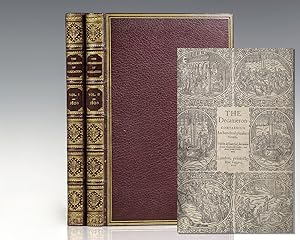
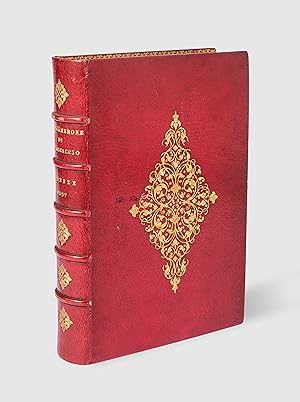
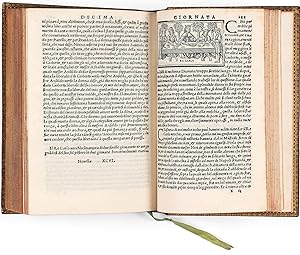
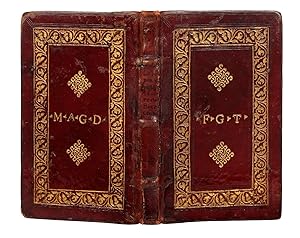
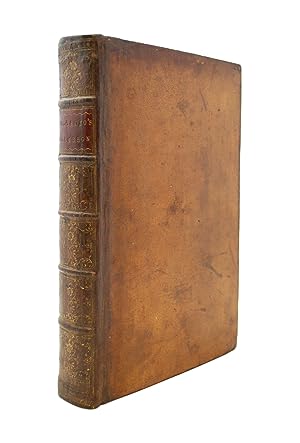
![Immagine del venditore per [The Decameron.] The Modell of Wit, Mirth, Eloquence, and Conversation venduto da Liber Antiquus Early Books & Manuscripts](https://pictures.abebooks.com/inventory/md/md31410068594.jpg)
![Immagine del venditore per The modell of VVit, Mirth, Eloquence, and Consueration. Framed in Ten Dayes, of an hundred curious Pieces, by seven Honorable Ladies, and three Noble Gentlemen. [with] The Decameron, containing An hundred pleasant Novels. venduto da Sokol Books Ltd. ABA ILAB](https://pictures.abebooks.com/inventory/md/md30878214096.jpg)
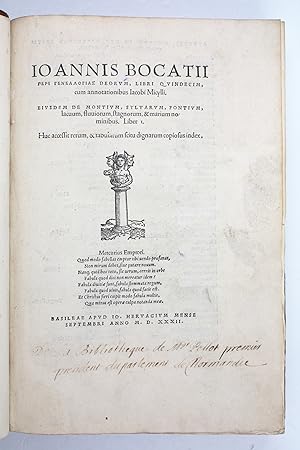

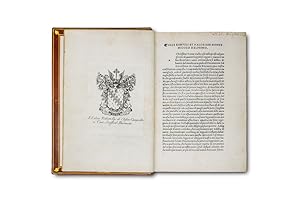
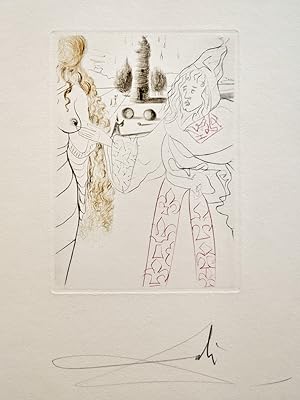
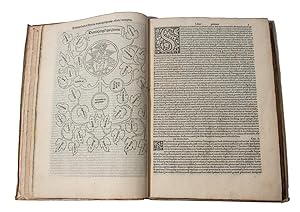

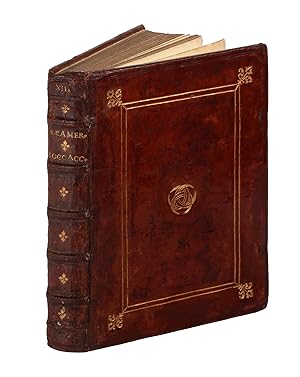
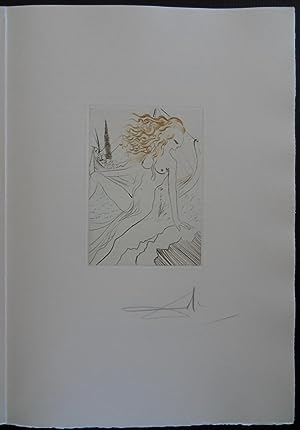

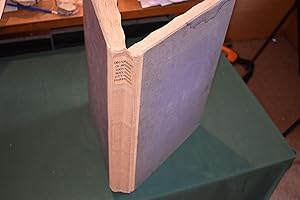

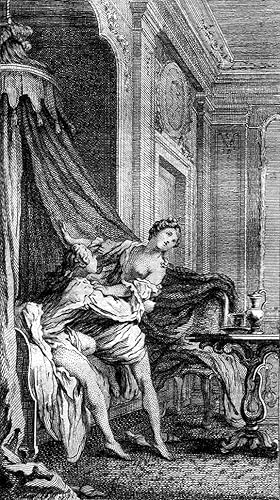
![Immagine del venditore per La Fiammetta del Boccaccio per Tizzone Gaetano di Pofi novamente revista. [Elegia di Madonna Fiamnmetta]. venduto da Librería José Porrúa Turanzas S.A.](https://pictures.abebooks.com/inventory/md/md30997105144.jpg)
